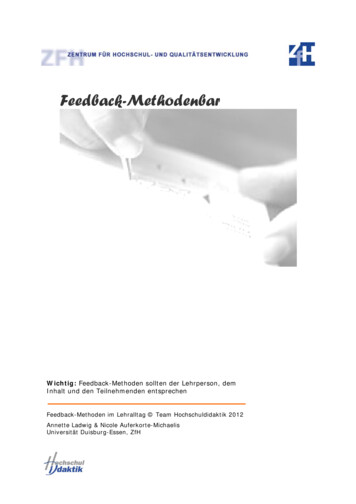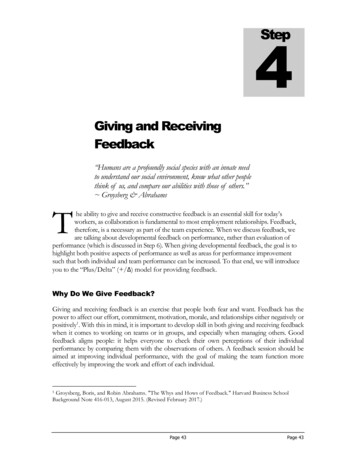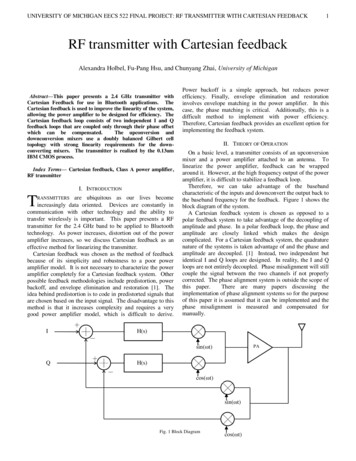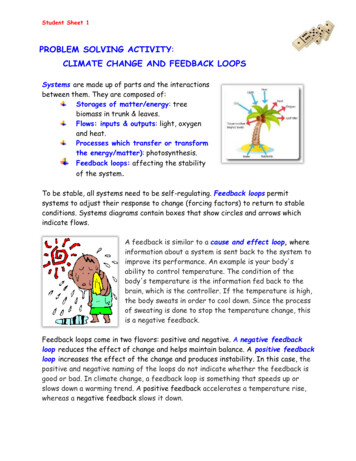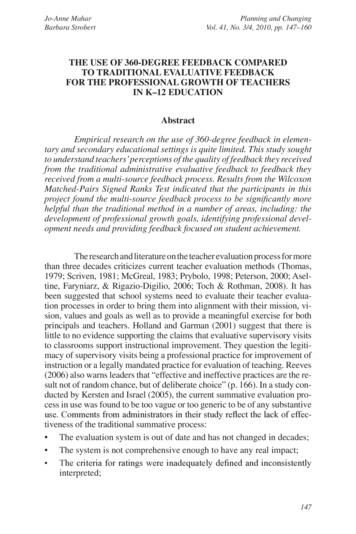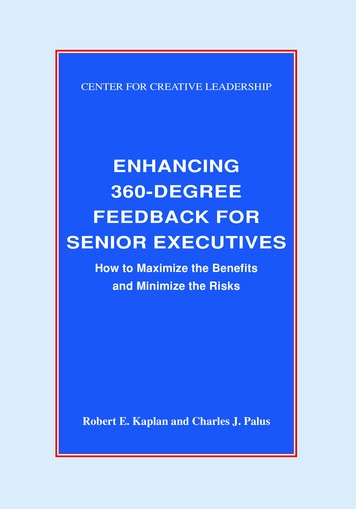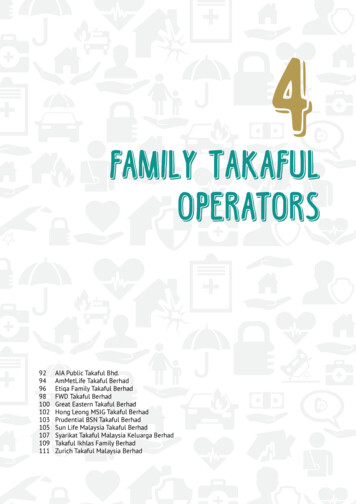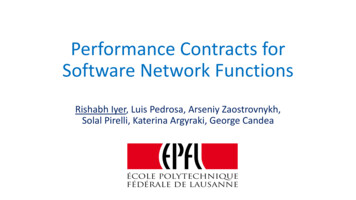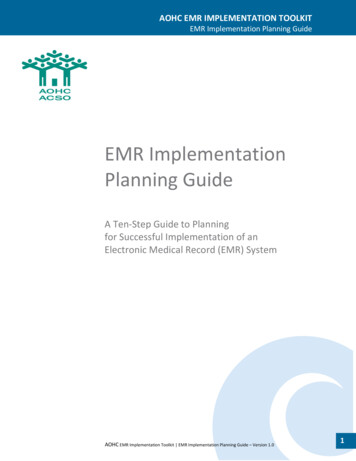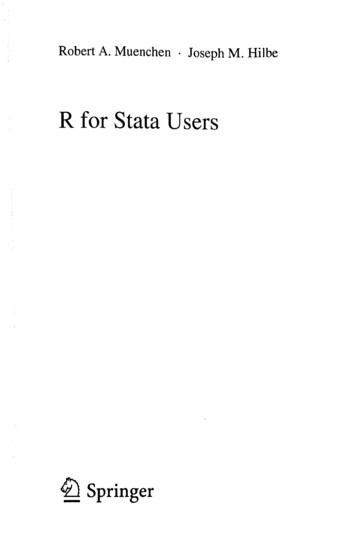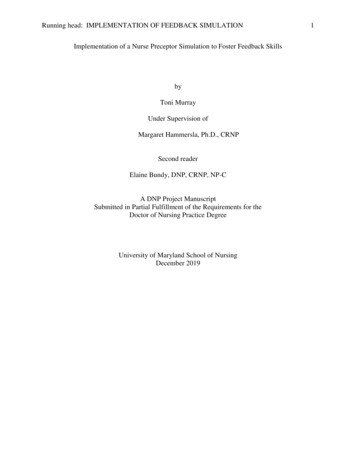
Transcription
Running head: IMPLEMENTATION OF FEEDBACK SIMULATIONImplementation of a Nurse Preceptor Simulation to Foster Feedback SkillsbyToni MurrayUnder Supervision ofMargaret Hammersla, Ph.D., CRNPSecond readerElaine Bundy, DNP, CRNP, NP-CA DNP Project ManuscriptSubmitted in Partial Fulfillment of the Requirements for theDoctor of Nursing Practice DegreeUniversity of Maryland School of NursingDecember 20191
FEEDBACK SIMULATION2AbstractBackground: Effectual feedback is an essential skill crucial to the preceptor role; preceptors areoften hesitant and uncomfortable with providing feedback. Inadequate preceptorship is aconsistent problem that has continued to affect the onboarding and retention of a qualifiedregistered nurses. In a national survey, timely and effective feedback was ranked the most criticalpreceptor skill by new nurses entering the practice. The provision of timely constructivefeedback is one of the core competencies of nurse preceptors. Feedback education issuccessfully provided through simulated crucial conversations by using standardized actors incommunication learning activities. The use of simulation in training can provide a safe andeffective learning environment where new skills can be acquired. The use of standardized actors,role-playing, scripted responses, and simulation has the potential to improve communicationskills by offering its participants life-like experiences. Nurse preceptors can benefit fromeducational activities that can improve feedback skills in the clinical setting during preceptorshipLocal Problem: Nursing leadership and nurse preceptors at a community hospital in Baltimore,Maryland identified preceptor development as an institutional priority. During the fall of 2017,preceptors (n 260) completed a needs assessment survey. In the survey results that over 44% ofthe nurse preceptors had no formal training for preceptorship; of those who had training, 42% ofthem received it over three years ago. Additionally, almost one-third of the preceptors perceivedthey were not proficient in feedback skills to new nurses and many were unsure if they werepreviously taught the skill during their program. The purpose of this Doctor of Nursing Practice(DNP) quality improvement project was to implement a feedback simulation into a currentpreceptor program, to foster preceptors’ skills for providing constructive feedback to new topractice nurses.Intervention: A quality improvement project with a simulation workshop was implemented toincorporate standardized feedback strategies. The simulation workshop included the use ofstandard actors, video-vignettes, and classroom learning activities to foster feedback skills.Results: Twelve experienced nurse preceptors from a 64-bed medical-surgical-telemetry unitparticipated in the project. The preceptors’ perception of their knowledge before the simulationwas rated as good (3.33 /- 1.15) and very good post-simulation (4.5 /- 0.52) on a 5-pointLikert scale. Using a specially designed feedback assessment form two Nursing ProfessionalDevelopment Specialists observed and scored the preceptors’ feedback behavioral skills duringthe pre and post-simulation. A paired t-tests and repeated-measures ANOVA statistical methodwas used to measure the trend in preceptor scoring. All preceptor scores showed statisticalsignificance (p 0.5) in all categories post simulation (establishing an engaging learningenvironment, maintains an engaging learning environment, structure the feedback conversationin an organized way, provokes an engaging discussion, identifies and explores performance gaps,and helps the learner achieve good future performance).Conclusions: The results of this project can be used to inform educational activities to supportpreceptor development in feedback skills. Simulated educational activities is a useful teachingstrategy that can improve nurse preceptor feedback skills in the clinical setting duringpreceptorship with the new nurse entering practice.
FEEDBACK SIMULATION3Background and SignificanceNew to practice (NTP) registered nurses (RNs) are an advanced beginner’s in nursingpractice (Benner, 1984) that enters the workforce with minimal competency to perform safely intheir role. These new RNs are challenged with caring for patients with complex health needs,clinical decision-making, effectively utilizing technology and navigating healthcare systems(Carabogim et al., 2017). Orientation, transition to practice programs, mentorship, and effectivepreceptorship are all essential in the NTP RNs’ success (Cotter & Dienemann, 2016). Nursepreceptors are identified leaders and experts in their practice environment whose roles includethat of an educator, socializer, protector, evaluator (Boyer, 2008), and role-modeler for the NTPRN (Ulrich, 2011; NCSBN, 2008), while also fostering effective communication, teamwork,clinical judgment, and safe practices (NCSBN, 2008). Inadequate preceptorship is a consistentproblem that has continued to affect the onboarding and retention of a qualified workforce (Roth,2015). In a national survey, timely and effective feedback was ranked the most critical preceptorskill by NTP RNs (Shinners & Franqueiro, 2015).Through anecdotal instances, nursing leadership at a hospital in Baltimore identifiedpreceptor development as a potential educational need. During the fall of 2017 a needsassessment was conducted via survey of preceptors (n 260). The survey found that over 44% ofthe preceptors had no formal training for preceptorship; of those who had training, 42% of themreceived it more than three years ago. Additionally, almost one-third of the preceptors perceivedthey were not proficient in feedback skills; many were unsure if they were taught the skill duringtheir program. Nurse preceptors can benefit from simulated educational activities that improvetheir feedback skills (Clark, C., 2019, Strickland & Welch, 2019, Murray & Buckley, 2017; Lin,E., Chao, S., & Chen, Y., 2013) in the clinical setting during preceptorship with the NTP RN.
FEEDBACK SIMULATION4Nursing preceptors are specialists (Roth, Figueroa, & Swihart, 2014) who play an integralrole in the preparation and socialization of the NTP RN (Ulrich, 2012, Cappelletti et al., 2014;Shinners & Franqueiro, 2017; L’Ecuyer et al., 2018; Cotter & Dienemann, 2016; Richards &Bowles, 2012; Spector, 2015). Highly skilled preceptors can model and transfer learning toothers; in this role, preceptors have a seminal role in improving patient outcomes, patient safety,and quality care (Roth, 2015). Effectual feedback is an essential skill crucial to the preceptorrole. Preceptors are often hesitant and uncomfortable with providing feedback (Jefferies &Hornsey, 2012). The provision of timely constructive feedback is one of the core competenciesfor nurse preceptors; their engagement in this competency supports life-long learning, skillacquisition, and proficiency (Roth, Figueroa, & Swihart, 2014; Roth, 2015; Finn & ChesserSmyth, 2013). Initial and ongoing preceptor education may assist them in their role development(Bradley et al., 2015; Windley et al., 2015; Cotter & Dienemann, 2016).Feedback education is successfully provided through simulated crucial conversations byusing standardized actors (SA) in communication activities (Clark, 2019, Strickland & Welch,2019). The use of simulation in training can provide a safe and effective learning environmentwhere new skills can be acquired (Murray & Buckley, 2017; Lin, Chao, & Chen, 2013). Thecombination of teaching strategies such as the use of SA, role-playing, scripted responses, andsimulation has the potential to improve communication skills by offering its participants life-likeexperiences (Clark, 2019; Strickland & Welch, 2019).The purpose of this Doctor of Nursing Practice (DNP) quality improvement project is toimplement a feedback simulation into a current preceptor program, to foster preceptors’ skills forproviding constructive feedback to NTP RNs. The short-term goals for this DNP project are to(1) pilot the feedback training and simulation on a medical-surgical unit for 12 preceptors and (2)
FEEDBACK SIMULATION5improve preceptor competence with feedback skills by December 2018. The overall goal of thiseducational innovation is to improve nursing practice and ultimately patient outcomes throughon-going preceptor skill acquisition and improved feedback to NTP RNs.Theoretical FrameworkDonabedian’s (1988) Structure-Process-Outcome (SPO) quality improvement(QI) model is a conceptual framework that will be used to guide the project. Gardner andcolleagues’ (2013) evaluated the use of the SPO framework to examine the impact of NursePractitioner services on safety and quality processes within a multidisciplinary team. Theauthors concluded that thorough attention given to structue and processes can assist in successfulimplementation of innovation. Beitz’s (2018) used the SPO QI model to examine the qualityissues that effected the care of bariatic patients. The author identified that although the structuralknowledge and equipement for the patient exist, it did not necessarily influence the process ofcare (biases and attitudues about obesity). These negative experiences to bariatic patients caneffect quality outcomes. In both studies, the SPO QI model was useful in guiding the projects inquality improvement initiatives.The SPO QI framework was designed to examine the quality of healthcare and healthcareservices. The context in which health care occurs is its structure (i.e., the facilities, staff,equipment, and budget). This is followed by assessing the process, the interaction between thepatient and the healthcare professional throughout the delivery care system. Lastly, outcomes arethe effects of healthcare and the healthcare system on specific populations or patients (i.e., achange in a patient’s health status as a result of an intervention). Each component in this linearmodel (structure-process-outcome) influences the next step. According to Donabedian (1988),
FEEDBACK SIMULATION6“good structure increases the likelihood of a good process, and a good process increases thelikelihood of a good outcome (p. 1745).”The Donabedian SPO QI model focuses on quality improvement in the context of thepractice environment. In the context of this project, it is operationalized to examine the learningenvironment of preceptors. The structure was adequate in that there was strong stakeholder buyin; the organizational characteristics and readiness for implementation of innovation wasfavorable; and the physical resources such as space, time, and equipment, and all associated coststo implement an educational intervention was available. The processes of developing andoperationalizing the feedback simulation for the preceptors and nursing professionaldevelopment specialists (who facilitate educational activities) was designed to consider thestakeholders and support sustainability and further dissemination. Good structure and process isexpected to positively impact the outcome; the preceptors’ knowledge, skills, and attitudes postimplementation of the feedback simulation was improved.Literature ReviewUtilizing simulation to facilitate the acquisition of feedback skills is the focus of theevidence in this literature review. Feedback skill is one of the core competencies for preceptorand a vital component for this role (Roth, Figueroa, & Swihart, 2014; Roth, 2015). The reviewwill begin broadly with the evidence supporting the need for feedback skills as a teachinglearning strategy. The report will conclude with current evidence regarding simulation and itseffect on learning and competency among health care professionals.Bing-You et al. (2018) conducted an integrative review of 51 articles on the dynamics offeedback between teachers and learners in medical education. Common themes amongst facultywere low-quality feedback and the reluctance to provide or limit constructive feedback to
FEEDBACK SIMULATION7learners across multiple contexts (verbal, written, videotaped, audio-taped, feedback cards,examination, and combinations thereof). The authors concluded that learners in the medicalsetting did not receive adequate feedback and recommended that the number of educators belimited to a well-trained cohort in order to improve competency with feedback skills. Facultyrequire an opportunity for deliberate practice of feedback skills. Limitations of the reviewincluded its lack of generalization to other learners (86% were medical students).Lefroy et al. (2015) developed evidence-based guidelines through a consensus iterativeprocess, for formative feedback in clinical education. The guidelines were organized in a set of32 trichotomous questions (Do’s, Don’t, and Don’t know) and grouped into three categories: theprocess of feedback, the content of feedback, and the learning culture over time. The authorsconcluded that although feedback is a complex process that is highly contextual and cannot begeneralized, it is necessary for learning. Lefory and colleagues developed a feedback model todepict its process and outcomes, and they offered a new definition for feedback that is learnerfocused and promotes their engagement in the process. Feedback requires a culture that valuesfeedback, includes it in faculty development, and has feedback opportunities built into its system.Limiting the quality of the evidence was a lack of a systematic search method of the guidelines.Strengthening the guidelines was the evaluation by expert opinion of four authors in the field ofeducation.The Core Curriculum for Preceptor Advancement (Roth, 2015) identified simulation forpreceptor-in-training as a beneficial tool for developing communication skills and other nontechnical skills. Simulation experiences can improve mastery of preceptor skills as they engagein deliberate practice. The use of standardized actors, pre-recorded videos, and human
FEEDBACK SIMULATION8simulators was identified as the best methods to facilitate learning of preceptor competencies.Authors from several studies also show an increase in confidence/self-efficacy in various skillswith the use of simulation as a teaching strategy (Kimhi, Reishtein, Cohen, Friger, Hurvitz &Rinat, 2016; Curl, Smith, Chisholm, & Kumar, 2016; Silberman, Litwin, Panzarella, &Fernadez-Fernandez, 2016). Using a debriefing and self-reflection model during the simulationwas shown to further develop competencies such as feedback in the preceptor (Roth, 2015).Similarly, the International Association for Medical Education (AMEE) published evidencebased practical guide for simulation in healthcare that supports simulation as a component tolearning and competency development (Motola et al., 2018). In combination with other teachingmethods and assessments, simulation can provide an opportunity for preceptors to practicefeedback skills in a safe environment.Roze des Ordons et al. (2018) examined faculty preceptors’ feedback conversationalbehaviors (approach, inquiry techniques, flexibility in adapting techniques to context,articulating observations, and shared understanding of gaps and plan for improvements). Facultypreceptors (n 18) participated in four videotaped feedback simulation sessions with actorresidents and patients, facilitated by nurse and physician educators experienced in leadingsimulation and debriefing. The preceptors had a range of six months to 35 years of clinicalexperience, and some seven of the thirteen had previously participated in a workshop onfeedback. The authors found variability in how the preceptor feedback conversation aligned withthe recommended guidelines by Lefroy et al. (2015). They were sometimes ill-prepared andinflexible in their approach. They concluded that simulated activities in feedback conversationskills and deliberate clinical practice could improve competence in the provision of feedbackskills. Limitations of the study include the lack of generalizability across settings and
FEEDBACK SIMULATION9disciplines; reliability and validity are potentially compromised while converting videos-toaudio-to-textual data for analysis; this can also introduce moderator bias. Lastly, almost 40% ofthe participants had prior education with feedback methods (the different types of feedback arenot shared in the study) which could have influenced the study results.Literature SynthesisThe importance of effective feedback skills for clinical trainers (preceptors) has beenwidely studied across varies settings and disciplines. Without instruction and ongoing educationin feedback skills, preceptors potentially provide inadequate and inconsistent feedback to theirnurses (Bing-You et al., 2018; Lefroy, 2015). There are a limited number of high-qualityresearch studies evaluating the best methods to assist preceptors with feedback skill. However,simulation with the use of standardized actors and other mixed-methods has yielded animprovement in skill acquisition, self-efficacy, and overall satisfaction in the learning method(Clark, C. 2019; Strickland & Welch, 2019; Murray & Buckley, 2017; Lin, Chao & Chen, 2013).Although Roze des Ordons et al. (2018) incorporated the use of videotaping and standardizedactors in their study, the authors along with Roth (2015) agree that conversational skills can bebest supported using simulated activities and require deliberate practice and on-going education.The literature is consistent in the use of ongoing training and deliberate practice via simulation asconsistently shown to facilitate the development of competency in feedback conversation skills.The supporting evidence shows initial and ongoing practice with feedback methods in simulationhas the potential to improve preceptor competency and confidence in the provision of feedbackto NTP RNs in the clinical setting.DNP Project Implementation
FEEDBACK SIMULATION10Description of ProjectThis simulation implementation project incorporated standardized evidence-informedfeedback strategies to foster feedback skills in 12 experienced nurse preceptors from a 64-bedmedical-surgical-telemetry unit at a community hospital in the fall of 2018. The simulationincluded the use of standard actors, video-vignettes, and classroom learning activities.Collaboration on the pedagogical design of the feedback simulation included two simulationexperts (SE) from the simulation training and education center and three Nursing ProfessionalDevelopment Specialists (NPDS), with experience in instructional simulation and debriefingmethods. The NPDS helped the project leader in facilitating the pre-simulation-education-postsimulation activity over 14-weeks. The simulation scenario was a video-vignette depicting apatient, played by a standardized actor, exhibiting signs and symptoms of an acute stroke. Thescripted scenario (Appendix B and Appendix C) proceeded with a new nurse, played by astandardized actor, who misses the patient’s change in condition. This was followed by thepreceptor giving feedback to the new nurse (standardized actor) to help develop feedback skills.Methodology/ToolsThe Simulation Module for Assessment of Resident’s Targeted Event Responses(SMARTER) methodology (Appendix D) was used to design the scenarios and scripts for thestandardized actors within the simulations. Onello’s (2015) Feedback Assessment for ClinicalEducation (FACE) [ copyright 2018 Center for Medical Simulation, Inc, Boston MA, USA,https://harvardmedsim.org/. All rights Reserved, used with permission.] (Appendix E andAppendix G) was used as a guiding competency to develop the targeted responses during thesimulation assessment and evaluation.
FEEDBACK SIMULATION11FACE is a behavioral assessment tool to evaluate instructor competency inconversational feedback skills. The tool was also designed as a framework to guide feedback.This theory-based and evidence-informed tool adapted from the Debriefing Assessment forSimulation in Healthcare (DASH) model, a valid and reliable tool used in academia and clinicalsettings. Onello (2015) established quantitative content validity for the six-element criterionreferenced tool (Appendix E); although it lacks further psychometric testing, it is useful in theassessment of feedback skills in the clinical setting.Simulation ActivityThe preceptors attended a two-day simulation workshop (pre-sim/education/post-sim).There were four-course sections available for them to register for attendance between Septemberand November of 2018. The simulation activity included three separate events over two halfdays. On the first day, the preceptors began with refreshments and a review of the workshopobjectives. Each preceptor watched a two-minute video-vignette of a nurse-patient clinical eventand then individually participated in a 15-minute pre-simulation session to assess their currentfeedback skills with a preceptee (SA). After the preceptors completed the pre-simulationassessment, they returned to a classroom to begin the three-hour education on feedback skills,facilitated by an NPDS. The exercises and class discussions were robust, and the preceptorscould share and ask questions. The preceptors had an opportunity to review the content andpractice the skills learned before returning the following day, for the post-simulation assessment(Appendix F) followed by a debriefing with the NPDS. On the second day, two NPDSindividually assessed the nurse preceptor’s feedback skills during the post-simulation Eachpreceptor was allotted 90-minutes to complete the post-simulation with a debriefing.Procedures/Timeline
FEEDBACK SIMULATION12During weeks one to two, the project leader sent initial email correspondences to thepotential preceptors identified by the pilot unit’s nursing leader, to provide details of the projectand instructions how to register for the workshop if they choose to participate. A subsequentemail was sent thanking the registries for their registration and confirmed their class dates.During weeks three through 10, the 12 preceptors completed the two-day feedbacksimulation workshop. There were four training cycles available for the preceptors to choose toaccommodate the unit’s staffing needs and flexibility to the participants. Three of the fourworkshops were held based on their registration. Each of the three workshops had four preceptorparticipants. The three NPDS shared the responsibility to facilitate the pre and post simulations,and one had the sole responsibility of teaching the didactic portion. The training cycle consistedof two parts; a pre-simulation and two-hour didactic training session on feedback strategies andthen a post-simulation within two days that were debriefed by an NPDS. During weeks 11through14, the project leader held a post-debrief for the feedback simulation with the NPDS andthe simulation experts on facilitators, barriers, opportunities for improvements, followed by thenext steps for sustainability and dissemination.Data Collection and AnalysisEach feedback conversation between the preceptor and preceptee (SA) was observed bytwo NPDS and evaluated independently for a pre-simulation and a post-simulation using themodified FACE Tool (Appendix F). A comparison of the NPDS pre- and post-scores evaluatedobservational inter-rater reliability. The NPDS discussed discrepancies in scoring after eachsession.Descriptive statistics were reported to describe the population (Table 1). Quantitativemethodologies were used to analyze the preceptor feedback behavioral elements during the
FEEDBACK SIMULATION13simulation; the scores from the pre-simulation and the post-simulation were used to conductpaired t-tests and then repeated-measures analysis of variance (ANOVA) to determinedifferences based on learner populations (Table 2). A Mixed Effect Model was computed tostrengthen the validity of the data. Concordance Correlation Coefficients were computed on theNPDS’s pre- and post-data to assess agreement between raters (Table 3).The statistical analysis was computed using Microsoft Office 365, Excel Statistical Pakand with the assistance of a biostatistician provided by MedStar Health Research Institute. Alldata were de-identified to limit risks to the participants.Protection of Human SubjectsA query was submitted to the Institutional Review Board with the University ofMaryland Medical System and MedStar Health Research Institute and determined as NonHuman Subjects Research. Measures taken to protect the participants included scanning andstoring all assessments in a password protected computer; placing original copies in a lockedshredding bin and disposed of like other protected health information by federal/state law; andde-identifying data before statistical analysis. Preceptor participation in the project wasvoluntary; individual scores are private; their performance in the workshop will not affectemployment or their effect ability to function as a preceptor.ResultsModificationsOne SA was requested for the simulation demonstration to promote continuity andconsistency with the script for each nurse preceptors. Due to scheduling availability, two SAswere trained by the project leader to share the responsibility of the pre and post-simulationinteractions with the nurse preceptors. Secondly, one of the NPDS was unable to complete all
FEEDBACK SIMULATION14the sessions due to an unforeseen obligation, and the third NPDS filled the gap. Theseunexpected changes came before the first day of training and accommodations were madequickly and seamlessly. The SA and NPDS were both competent to perform the roles. Lastly,the planned 90-minute debriefing for the post-simulation took on average 40-minutes (30-50minutes).Data Analysis and DemographicsData reports were generated by decoding the findings collected from the modified FACETool assessments. The coded data was computed by a Microsoft Office 365, Excel StatisticalPak and the assistance of a biostatistician. All twelve nurse preceptors attended both workshopdates and completed the surveys; pre- and post-simulation assessments were obtained for thetwelve participants, representing a 100% response rate. Two NPDS evaluated each preceptor'ssimulation sessions. Four of the preceptor’s pre-simulation was evaluated by a different NPDS(back-up) that facilitated the session in the absence of the primary facilitators.Most of the participants were female (99.9%) and Baccalaureate prepared (67%) (seeTable 1 for full descriptive statistics). Most of them had limited experiences in the role ofpreceptor: four or less years of preceptor experience (92%), never received formal preceptortraining (42%), and had two or less opportunities to formally precept a new nurse. Prior to theworkshop, the preceptors rated their current knowledge for feedback strategies and evaluated theclassroom content facilitated by the NPDS. The overall program evaluations were rated as verygood and their perceptions of their knowledge post-simulation as very good. See Tables 4 forsummary of results.The preceptors’ performance behaviors were assessed during the pre- and postsimulations using the FACE tool. There was a total of six behavioral elements, each having an
FEEDBACK SIMULATION15additional subset of elements accompanying it for a total of 22 questions (appendix F). The firstthree questions were not used in the data analysis because of the lack of appropriateness to thescenarios (Table 2). The trend in scoring by NPDS was evaluated by using paired t-tests andrepeated-measures ANOVA (Table 2); the data was then evaluated for agreement between ratersusing the concordance correlation coefficient (Table 3). A mixed effect model was used tocapture both the fixed and random elements that occurred with the NPDS scoring for the pre- andpost-simulation data. This method can be useful when the same statistical data is measured overtime.ResultsThe anticipated outcome for the context of this project was to improve preceptorcompetency in the delivery of feedback to preceptees (SA) in a simulated environment aftereducation. The preceptors were assessed using the modified 19 individual behaviors from theFACE Tool pre-and post the education by two NPDS. The data (Table 2) averaged the scores forall the preceptors per behavior to show the overall mean, standard deviation, and standard error.The paired t-test showed significant improvements (p 0.01) in sub-elements associated withfour of the overarching behavioral elements: establishes an engaging learning environment,maintains an engaging learning environment, identifying learning gaps, and helping learnerachieve or sustain good future performance for both NPDS scoring. The standard error wascomputed to estimate population parameters from the known sample statistics. Standard error isuseful method of measurement for small sample sizes. Table 2 compares the difference betweenthe two NPDS standard error and estimates there would be improved behaviors in all elements toinclude structuring feedback conversation in an organized way and provoking engagingdiscussions. The agreement between raters was variable but mostly improved with the second
FEEDBACK SIMULATION16scoring of the preceptors (Table 3). Concordance correlation coefficient ratings were measuredto evaluate inter-rater reliability in the second scoring and ranged from 0 to 0.903.In the context of the clinical setting (simulation lab), there were no differences notedbetween the observed and anticipated outcomes. The preceptors were homogenous in theirinitial knowledge for feedback strategies and none of the participants could articulate a feedbackmethod they routinely used in their practice setting. There were overall improvements after theintervention in feedback skills. The implementation of the simulation went smoothly, and theparticipant’s verbal statements of improved competency were validated by the modified FACETool and self-perception questionnaire.Strengths. The simulation, vignettes, and scripting were engaging and useful
Maryland identified preceptor development as an institutional priority. During the fall of 2017, . The purpose of this Doctor of Nursing Practice (DNP) quality improvement project was to implement a feedback simulation into a current . transition to practice programs, mentorship, and effective preceptorship are all essential in the NTP RNs .
